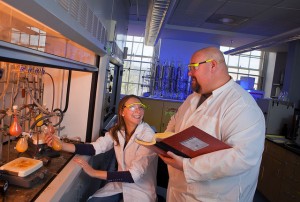Chip Nataro brings the idea of student-focused teaching and research to a whole new level. He often includes students in his organometallic chemistry research. In fact, he says his research is “entirely dependent” on student participation.

Chelsea Mandell ’12 works with Chip Nataro, associate professor of chemistry, in the inorganic chemistry lab in Hugel Science Center.
Nataro’s deep commitment to mentorship is something he discovered within his first week at Iowa State University, where he earned his Ph.D. in inorganic chemistry. As a teaching assistant, he ran two weekly recitation sections for about 40 students and was their only source of help as the professor was inaccessible to most of the 350 students in lecture. That’s when he realized how much he liked the atmosphere of a small undergraduate institution; he earned his B.S. in chemistry at Messiah College.
“My research experience as an undergraduate was limited,” says the associate professor of chemistry, who joined Lafayette’s faculty in 2001. “The research I did in graduate school and in my post-doctoral work [at the University of Vermont] inspired me to work at an undergraduate school and to do meaningful research that would lead to quality publications.”
Nataro and his student teams study compounds that have a metal atom with other small molecules called ligands attached to it. These compounds, he explains, are most commonly used as catalysts. In Nataro’s lab, students work to create new compounds and study how small changes to the molecule change the structure and the electrochemical properties, which indicate how easy it is to remove an electron from the compound. Understanding those properties is important when considering what kinds of reactions the compounds can perform.
One of the larger projects Nataro is running in his lab started with work by Chelsea Mandell ’12, who graduated with a B.S. in biochemistry. Chemistry major Katie Gramigna ’13 (Summit, N.J.) and biochemistry major Maggie Tiedemann ’14 (Pittsburgh, Pa.) are continuing the project. Mandell and Tiedemann are perfect examples of Nataro’s dedication to getting students working on high-level research as early in their education as possible—both students started in his lab after their first year on campus.
Read a first-person article by Chelsea Mandell ’12 in Lafayette Magazine
Nataro admits that the material they cover in the lab goes well beyond that covered in the first year, but he has the confidence that, with his guidance, they can push their boundaries and drive the project. Gramigna and Tiedemann are making compounds formed by a bond between an iron atom and either palladium or platinum. The work is groundbreaking as very little is known about these particular compounds.
“I consider research to be some of the most important teaching that I do,” says Nataro, a recipient of the College’s Thomas Roy and Lura Forrest Jones Lecture Award. “A research experience is critical in the development of a practicing scientist. I show students the techniques they need to use to work in the lab, but I want them to be performing the work as soon as possible. They can learn quite a bit by watching, but they learn so much more by actually doing the work. I am always around to help them out, but I want them to take full ownership of what they are working on.”
Mandell, Gramigna, and Tiedemann attended the National Meeting of the American Chemical Society in San Diego in March to present their results. The group attended the meeting with funds from the College and Nataro’s $127,000 National Science Foundation grant, which runs through 2014.
Nataro realizes that starting students on research so early in their academic career creates a steep learning curve, but the payoff comes when they start to see the bigger picture in their senior year. Mandell, for example, made good decisions about conducting experiments and interpreting results. She even left a to-do list for the team when she graduated.
“That’s my dream outcome,” says Nataro. “Chelsea is heading off to graduate school, and she is so much more ready than I was at that stage in my career.”
This summer, Nataro discussed their work at the Gordon Research Conference on Organometallic Chemistry in Newport, R.I. He was one of only a handful of faculty from undergraduate institutions invited to the conference; other attendees are from research institutions, national labs, and industry. Gordon Conferences are very small and discipline-specific, allowing participants to discuss research and results that are not yet published.
He was also able to catch up with a few other very successful former students at the conference: Christine Thomas ’01, assistant professor of chemistry at Brandeis University; Abby O’Connor ’03, an assistant professor of chemistry at the College of New Jersey; and Alison Campbell ’04, a research scientist at Eli Lilly.
